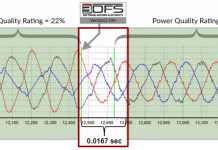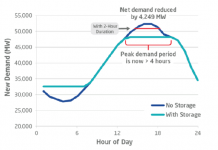Perhaps ironically, it took one of the worst financial and economic crises of the past three decades to bring "the grid" into investor focus. To be sure, certain alt energy aficionados such as Tom have been on this topic for a long time (Tom is actually the one who introduced me to the grid as an investment theme). However, it is fair to say that most investors, including alt energy investors, have not historically paid the grid a huge deal of attention.
That is because most people outside of alt energy and VC circles held, until recently, the Old World view of the grid. In the Old World, the grid was a collection of transmission and distribution systems (i.e. transmission towers, utility posts and wires) connected together by the odd utility sub-station. In the Old World, investments into the grid mostly took the form of maintenance capex by utilities, and there was little growth, at least in North America, beyond what was needed to keep up with economic and demographic expansion (2-3% per annum often offset by efficiency gains). Though antiquated and inefficient, the system mostly ‘did the job’ and the lack of coordination between various actors meant that no one would take the lead on massive investments required to upgrade the old infrastructure. In the Old World, the grid was nothing to write home about from an investment perspective.
Enter the New World, the world of the smart grid, where the electric grid doesn’t stop at the connection with your house or office building, but can potentially extend all the way into nearly every electric device you use – if it can be plugged in, it can be made ‘smart’. In the New World, IT capabilities are leveraged to optimize grid management. In effect, energy management, which used to rely on a closed system approach, is now integrated with the grid, opening a whole New World of possibilities. (I am admittedly not an expert in the technological ramifications of the smart grid and this post is not about the tech side. I find SmartGridNews.com to be a great source of info. I liked their reviews of various smart grid technologies)
The New World has actually been with us for some time. Smart grid pure plays such as Comverge (COMV), RuggedCom (RUGGF.PK) and EnerNOC (ENOC) all IPOed in Q2 2007, raising the profile of New World investment opportunities. However, in the broad world of alt energy investing, smart grid plays were often overshadowed by the mightier solar sector, in part because growth rates were far higher and in part because the smart grid business model is a bit arcane.
Fast forward to the 2008 US presidential run-off, where the leading candidate, Barak Obama, spoke repeatedly of the need to invest massively into the US power grid to make it smarter and more efficient. Most people probably can’t remember the last time they heard a presidential candidate make the electric grid a central pillar of his/her energy policy. Nearly immediately following the election, the new President pumped, as part of his American Recovery and Reinvestment Act, $4.3 billion into mostly New World grid opportunities.
While this may seem small in comparison to the total size of the investment required to upgrade the grid (Old and New World) over the next couple of decades (The Brattle Group estimates that around $880 billion in transmission and distribution investment will be made by 2030), this amount is over 15x the combined 2008E sales of Comverge, RuggedCom and EnerNOC. Throw in Itron (ITRI), a $2 billion company that provides a number of utility products and services beyond smart meters, and the final package is still over 2.2x the combined 2008E revenue of all four companies. In other words, for this emerging sector, this is a fair chunk of change.
Besides the revenue that will flow in as a result of direct government expenditures, the impact of the American Recovery and Reinvestment Act will be felt for years to come as it jump-starts the industry. And the US isn’t alone: the Canadian province of Ontario established a Smart Grid Forum that recently recommended spending C$1.6 billion over the next five years on smartening the grid there. Smart grid opportunities are also attracting large firms with no energy management background but expertise in complementary areas that can be leveraged.
Where does that leave investors? With the very real possibility that smart grid stocks will outperform the broader alt energy space over the next 12 months. Like other areas of alt energy, there are a growing number of ways to play the smart grid as larger cap firms with diversified revenue sources enter the space. The table below lists out some of the main publicly-traded plays on the smart grid.
| Smart Grid Stocks | ||||
| Name | Ticker | Exposure to SG | Mkt Cap ($mm) | PE |
| RuggedCom | RUGGF.PK | Very High | 252 | 18.88 |
| Comverge | COMV | Very High | 103 | n/a |
| EnerNOC | ENOC | Very High | 225 | n/a |
| Itron | ITRI | Very High | 1,810 | 66.39 |
| Echelon Corp | ELON | Very High | 287 | n/a |
| Digi International | DGII | High | 192 | 20.19 |
| IBM | IBM | Medium | 123,260 | 10.24 |
| Cisco | CSCO | Medium | 90,878 | 12.12 |
| GOOG | Low | 110,110 | 26.24 | |
To be sure, I am a little late on this one. Although I did discuss the potential for the smart grid to receive some focus in Obama’s economic stimulus package in December, I initially believed that the Old World grid would receive as much if not more than the New World grid. In the end, Old World got next to nothing, which somewhat surprised me given its state of disrepair.
While I don’t expect the smart grid to move the needle for the companies whose exposure is categorized as "medium" and "low" in the table above, my sense is that the "very highs" and the "high" will outperform alt energy stocks in general over the next 12 months. We will check again then!
DISCLOSURE: Charles Morand does not have a position in any of the stocks discussed above.
DISCLAIMER: I am not a registered investment advisor. The information and trades that I provide here are for informational purposes only and are not a solicitation to buy or sell any of these securities. Investing involves substantial risk and you should evaluate your own risk levels before you make any investment. Past results are not an indication of future performance. Please take the time to read the full disclaimer here.









Your P/E for RuggedCom looks a little high- I think TTM P/E is more around 19x right now. Did you account for the currency conversion (share price in CDN, financials in USD?)
Good catch PB – I fixed it.
What about ABB? As a global European-based company, will they benefit from smartgrid in the US?
It seems that to abandon the Old World and enter the New World is only needed to touch a switch and we will have achieved instantly our goal!!!
Neither the Old World is so bad, nor the New World is so good as you despict.
And keep this in mind: Smart Grid is not only about implementing Information and Communications technologies in the grid. This would be only “half-smart-grid”. Smart Grid is mainly Power Electronics as well. Smart Grid is mainly about heavy currents Electronics not about light currents Electronics. Currents in power lines are heavy currents not light currents. Electric grids are not Communication grids, the main diference is currents and inertia. Communications grids are inertialess. To manage inertia and heavy currents we need Power Electronics, not only Electronics. Electrical engineers know very well which is the diference between both kinds of electronic devices. It is time all the people who make comments about Smart Grid start tolearn that difference and understand the improtance of Power Electronics por Smart Grid development. Up to now the focus in only on Information and Communication technologies. In my opinion, to keep the focus anchored or latched like that is an error. The New World would be only “half” New World. And remember, Old Grid let a century of economical development, it worth something better.
Lisanne:
Bravolito provided a partial answer to your question.
If you Google “ABB smart grid”, this is the first you get: http://www.abb.ca/cawp/seitp202/3e22c0f632c49999c125755800491d81.aspx
ABB is active mostly in power electronics and less so in communications equipment for the grid. The companies I listed in the article really specialize in communication applications.
As to whether ABB will benefit, it’s a little early to tell. Once the contracts are announced, we’ll get better visibility. My sense is that they will benefit. At least some of these contracts will involve consortia of firms with various expertise, and I could see them being a part of some of those consortia.
That said, I’m unsure whether the money involved will be needle-moving for ABB. Billions in Old World grid would have been better.